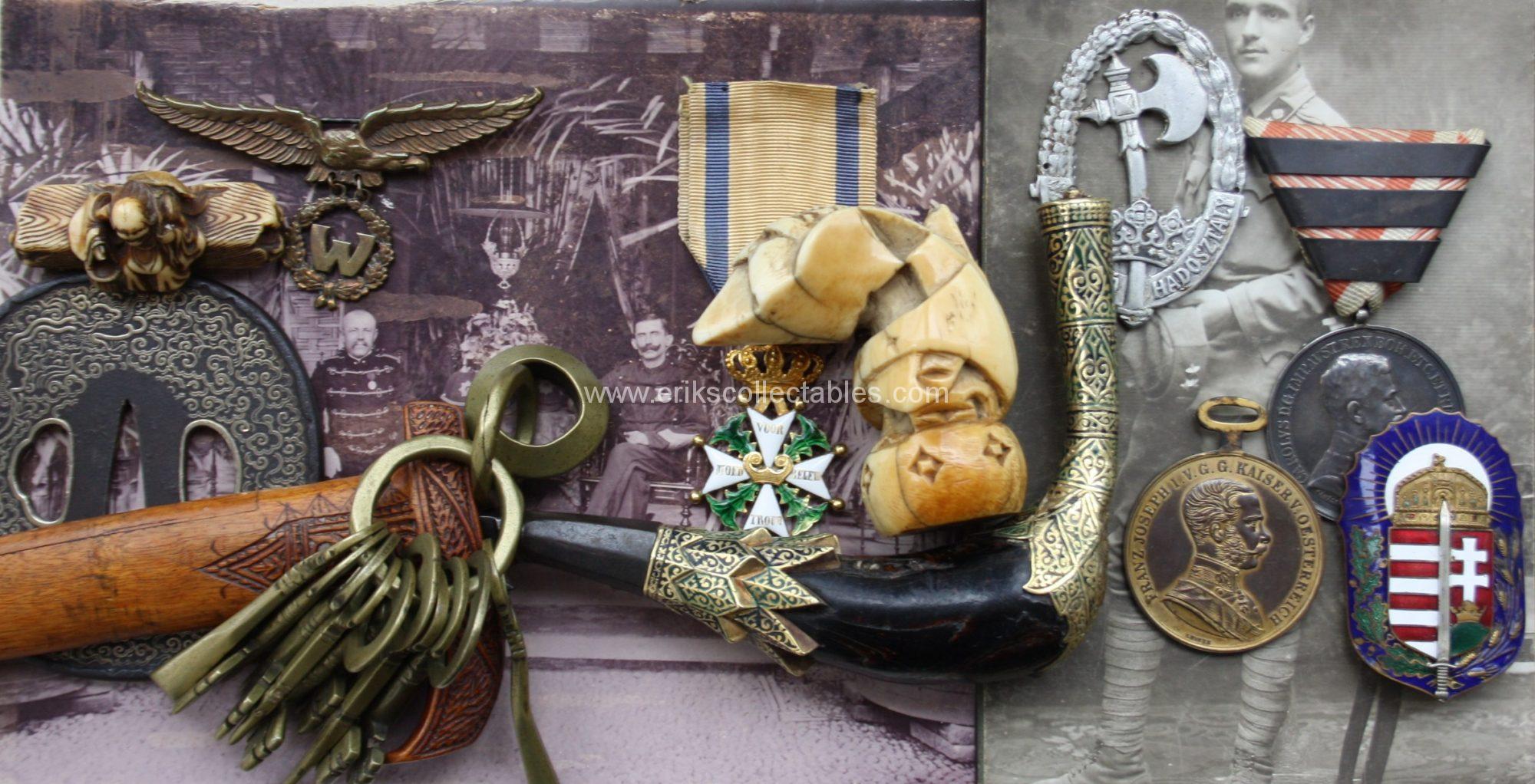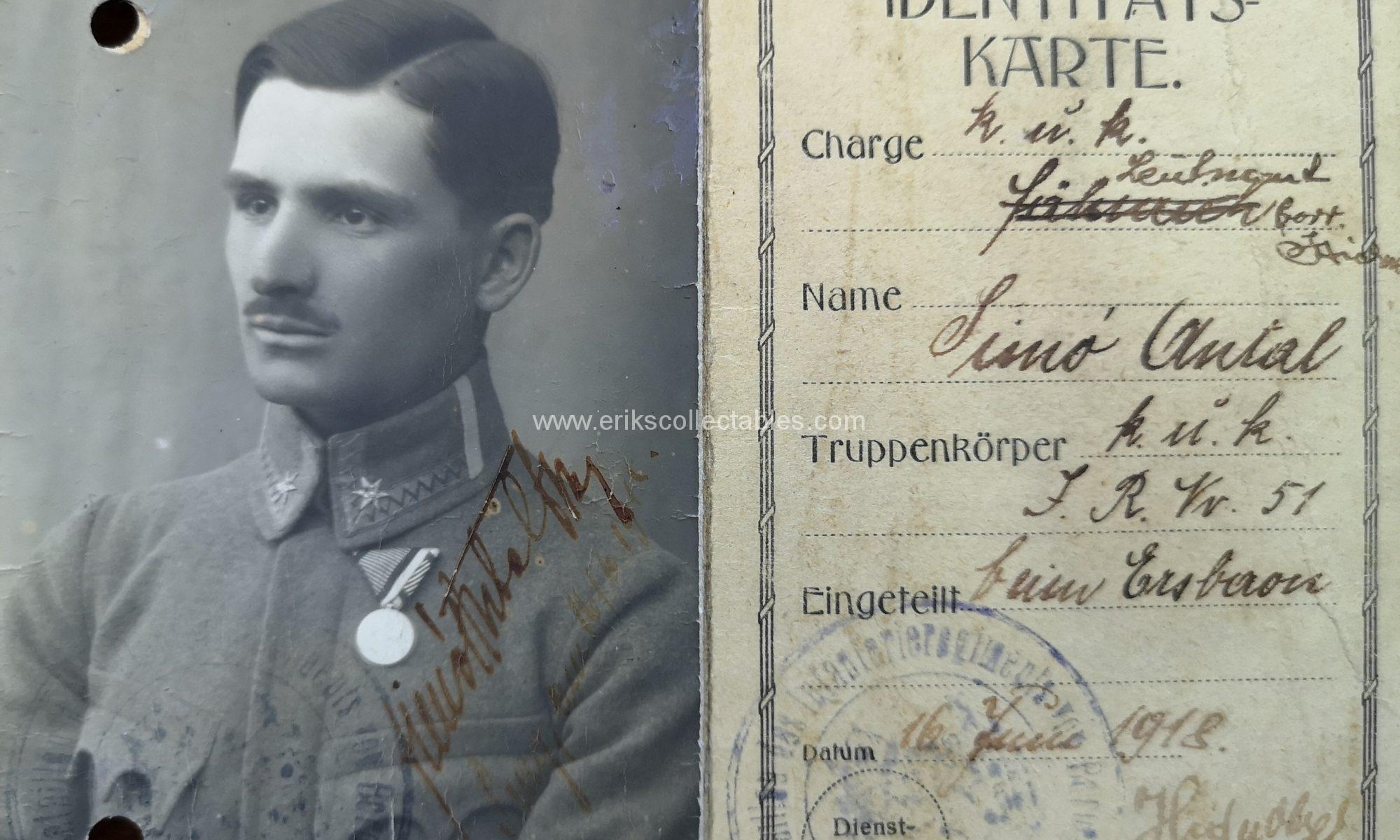This group consists of the documents of Antal/Anton Simó, lieutenant in the reserve of KuK Infantry Regiment 51. As he lived in the Transylvania region he became a Rumanian citizen after WW1 as a consequence of the Trianon treaty.
In 1941 as a result of the last Hungarian re-annexation action Transylvania became part of Hungary and he became a Hungarian citizen again. All the Austro-Hungarian medals could be worn and used in Hungary but obviously not in Rumania.
So in 1941 he could apply for all his relevant WW1 medals and also apply for the vitéz order as a Hungarian citizen. He also moved to Budapest and worked for the Hungarian railways. (MÁV).
His ID card from 1918 showing him with the 2nd class Bravery medal and with the rank and photo of fähnrich, later crossed out and changed in Leutnant. As all officers in training he first went through the nco ranks in which period he was eligible for the Bravery Medals to the ranks below officer!

His Bravery medal 2nd class would be awarded for actions in 1916 as described below in the request form. The request forms come from the Hugarian Military Archives!

Text of the request: In Annerkennung tapferen Verhalten vor dem Feinde. Im Gefechte vom 7. und 8. Juli 1916 Sudlich Podgaino Ubernahm er nach Verwunding des Zugskommandanten das Kommando in dem Zeitpunkt als der Feind bereits an der innersten Hinderniszone war und drangte denselben durch seine Entschlossenes tapferes Aufträten wobei er an der spitze sienes Zuges Kämpfte zuruck. Bracht ihm durch geschickte Feuerleitung grosse Verluste Bei.
Translation: In recognition of brave conduct in the face of the enemy. In fight from 7th and 8th of July 1916, south of Podgaino. He took over command, after the commander became injured, at the moment that the enemy already was at the innermost defense line and forced them back, by his convincing brave action, in which he fought at the front. Inflicted great losses to the enemy by his adequate fire direction.
From the history book of the Worldwar, book II, 1920: 7. Juli griffen zwei neue russische Korps im Räume Karczewo-Wygoda das Kolozsvärer Infanterieregiment Nr. 51 an, ‘das bei Tuganowiczi und Podgaino stand, heldenmütig die Stellung hielt und alle Angriffe erfolgreich abwies. Am 8. Juli 2 Uhr vormittags erfolgte ein erneuter heftiger Angriff, welcher den ganzen Tag andauerte. Vor der Front der 51er lagen über 2000 Tote, ohne daß das tapfere Regiment auch nur einen Schritt zurückgewichen wäre.
Translated: On July 7th two Russian corps attacked in the area of Karczewo-Wygoda the 51st Infantryregiment from Kolosvar that bravely held the line near Tuganowiczi and Podgaino and rejected the attack succesfully. On the 8th of July at 14.00 hrs a new attack was launched that lasted the entire day. In front of the 51st there were more than 2000 death without the Regiment retreating even a step.
And the documents and texts relating to his first class Bravery Medal
Tapferes Verhalten vor dem Feinde: In der Durchbruchsschlacht am 24./X. 1917 bei (Punkt) 778 nördl Dol. Kal stürmte er mit der 1. Welle der 7. fkomp bis über die 2. fdl. Linie, wo er infolge schwerer Verwundung abbleiben musste. Er gab ein mustergültiges Beispiel seiner Mannschaft.


Translation of text: Brave conduct in the face of the enemy. In the breaktrough fight on the 24th of October 1917 at point 778 north of Dol. Kal. he stormed with the first wave of the 7th field company beyond the 2nd enemy line, where he, as a result of a major injury, had to stay behind. He was an example to his men.

The date of this action is the start of the 12th Isonzo battle in Italy! In October 1917 the Kolozsvárer IR.51 took part in the Isonzo / Karfreit breakthrough. The villages are Dol (east of Selo) and Kal (im Cepovantale). The regiment (three battalions) was together with IR.64 a part of the 69th Infantry Brigade. The regiment held a sector in the Cepovan Valley (Capovantal) on the Bainsizza Plateau.

As stated his other medals would be added only after 1941:




His entitlement in 1943 would have looked like this (these are not his medals as the group only existed of the papers).

With many thanks to the Hungarian Military Archives for helping with the relevant materials that made this blog possible!


